Have you noticed areas around your lawn that are dying or changing color? If so, you know how frustrating this can be. Especially after investing hard work and money into your lawn. Below we will talk about the top 5 diseases in CT and the best ways to control them.
Red Thread
-
How to identify Red Thread
- Red thread will cause a redish/pink color in the affected areas of your lawn. It is easiest to find this disease in the mornings when there is still dew on the ground.
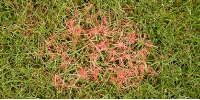
-
Will Red Thread damage my lawn?
- Red Thread will not kill your lawn. Although it may cause a very unsightly appearance to your grass, it will not damage it. One thing it can do is make your lawn more vulnerable to other diseases or insects.
-
How to prevent/cure Red Thread?
- Low nitrogen levels can cause Red Thread. Fertilizing your lawn will raise the nitrogen levels in your soil.
Summer Patch
-
How to identify Summer Patch:
- Summer patch will appear as wilted irregular circles up to 2 inches in diameter. The patches will be yellow/brown and increase in size throughout the summer. When taking a closer look at the grass blade you will notice that they are dying back starting at the tip.
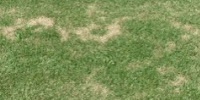
-
Will Summer Patch damage my lawn?
- Summer patch is a destructive fungus that will severely damage to your lawn if not taken care of. It will kill both the grass and the roots resulting in areas that will have to be re-seeded in the fall.
-
How to prevent/cure Summer Patch?
- Disease spreads when grass is wet. Watering in the morning will give the lawn a chance to dry out throughout the day.
Using a preventative fungicide as soon as soil temperatures reach 65 degrees will help keep your lawn green throughout summer.
Two or three applications in 1 month intervals is recommended. If your lawn does get summer patch, you can also use a curative fungicide that will prevent it from spreading and doing more damage.
Pythium
-
How to identify Pythium?
- Pythium will first appear as very small irregular shaped spots usually about 1/2in to 4in in size. If they are untreated, they will merge into larger patches. In later stages, it will resemble mini spider web patterns. If your grass is laying flat, this is most likely Pythium. It can be easily spread via lawn equipment and might present as "streaks" or tire marks that won't seem to go away.
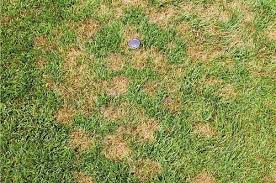
-
Will Pythium damage my lawn?
- Pythium can be very harmful to your lawn. It is very common in hot and humid weather. Pythium will destroy grass right down to the roots resulting in bare areas that will require re-seeding.
-
How to prevent/cure Pythium?
- Be cautious with foot traffic.
- After mowing, wipe off the mower blades to prevent the disease from being carried to other areas of your lawn.
- Water in the morning so grass blades can dry off during the day.
- Chemical treatments: Many are only available to certified professionals. If you are having problems curing it - give a local, trusted lawn care company a call.
- What Does Pythium Blight Look Like? [Disease Prevention]
- Prevent Pythium Disease [8 Ways to Avoid its Spread]
- Phosphite vs Phosphate [Treating Pythium Blight]
- The Disease Triangle [How to Prevent Lawn Disease]
Gray Leaf Spot
-
How to identify Gray Leaf Spot?
- Gray leaf spot will start off as tiny lesions on the grass blade. Over time, gray or tan spots will grow. These spots will eventually overtake the grass blade.
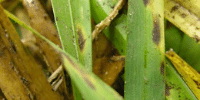
-
Will Gray Leaf Spot damage my lawn?
- If your turf is well established and healthy, Gray Leaf Spot should not pose a threat. However, if your turf isn’t well managed and the weather is warm and wet, this combination may cause Gray Leaf Spot to damage your lawn.
-
How to prevent/cure Gray Leaf Spot?
- Avoid watering in the evening and watering frequently. Excessive amounts of moisture over time can cause diseases to form and spread.
It is better to water deeply and infrequently.
Fungicides that can be used for gray leaf spot: Azoxystrobin, Pyraclostrobin, and Fluxastrobin.
Be sure to read labels to make sure it is being applied correctly and safely.
Dollar Spot
-
How to identify Dollar Spot?
- Dollar spot is usually a yellow or tan spot 2-6 inches wide. Spots can eventually grow into large irregular patches. Grass blades will often look like they are wet.
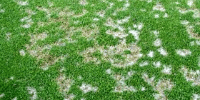
-
Will Dollar Spot damage my lawn?
- Dollar spot can damage your lawn if the temperatures are high during the day, cool during the night, and it is humid. It is most common on golf greens but can be a problem for lawns with dry soil.
-
How to prevent/cure Dollar Spot?
- Like most diseases, using deep, infrequent watering techniques is a great way to prevent from dollar spot. Fertilizing at appropriate times can help prevent or get rid of dollar spot. It is a low Nitrogen disease so a fertilization application with Nitrogen will help tremendously.
Bottom Line:
To reduce the risk of your lawn getting damaged by disease, thatch management and maintaining an ideal pH are critical. Planting disease resistant grass types is also highly recommended. Services such as Triple Aeration and Seed and spreading lime will go a long way to help you proactively fight disease damage to your lawn.
If this article was useful to you, read some others similar to it:
Since 2007, Green Meadow Lawn Care has provided homeowners throughout the greater Tolland, Connecticut area with premium fertilization programs, tick control, mosquito management, seeding & aeration and tree & shrub care.
Visit our Learning Center to find out more about how our services can help you or visit our Youtube Channel to view more in our Learning Center Series.
To speak to our Customer Service Manager, please call Dave (view Dave's video bio here) with any questions. Dave has been in the industry for 30 years and is always happy to help with his expert advice.
860-870-5700


